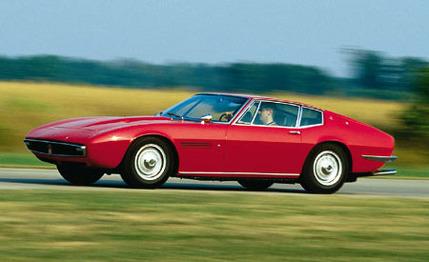 Specialty File
Specialty File
If our expectations for the new Maserati seem unduly high, blame the Ghibli. In fact, blame the Ghibli for completely warping our standards for automotive aesthetics since most cars sitting next to one look like cinder blocks.
It isn't their fault. The Italians routinely get away with design murder because they can't be bothered with temporal issues such as how to get Grandma Edna out or where to fit the tire chains. When it debuted at the 1966 Turin show, the Ghibli flouted so many of the design rules in Detroit that it was considered a rolling felony. Of course, that didn't stop Henry Ford II from famously buying the first one off the boat. Priced at $19,000, it cost him the equivalent of four new Thunderbirds.
Named after a North African windstorm, Ghibli production began in 1967 on Maserati's 41st anniversary as an independent company. The founding Maserati brothers - Bindo, Alfieri, Ettore, and Ernesto - were gone from the company, the great racing years were a fading memory, and the workforce at the factory in downtown Modena was spread thin, building 11 separate models of road cars. These were the halcyon days of the front-engined Italian. Orders with checks stapled to them poured into the exotic-car epicenter around Bologna, where the big-three nameplates and some tiny cottage firms were all building competing models and rushing more through development.
Like a lot of young designers, Giorgetto Giugiaro, then working for Carrozzeria Ghia in Turin, was busy trying to out-wow his competitors at Bertone and Pininfarina and win body supply contracts for his employer. He penned the two-seat Ghibli coupe in only three months and in 1969 the Ghibli spyder. Ghia took orders for a total of 1150 coupes between 1967 and 1972 and 125 convertibles.
As pretty as it was, the 3583-pound coupe was, even by the standards of the day, a technical has-been. To the rear of a typical body-integrated frame of welded steel tubes and flat panels was an ancient live axle riding on leaf springs. Independently sprung control arms carried the nose, but Lamborghini had introduced all-independent coil-over-damper suspensions to the class in 1964, and magazine reviewers (including ours) were beginning to expect them.
The cast aluminum DOHC 4.7-liter V-8 was a dry-sump variation on a racing design dating to the 1950s. The 85mm stroke, a country mile compared with the 60-to-70mm throws Ferrari and Lamborghini employed to make their V-12s sing to 8000 rpm, helped cap the Ghibli's redline at just 5500. The platoon of Weber DCNL carburetors standing at attention in the vee had throats enough for every cylinder, and they were key to the claimed 330-hp rating.
The V-8's link to the track is evident when you open the Ghibli's hood. Each spark-plug hole has a twin blank next to it where a second plug resided in the racing versions. What the 4.7 lacked in cylinders, twist, or easily serviced components, it compensated for with low-end torque: 340 pound-feet at 3500 rpm.
The 1967 Ghibli pictured here, which adorns the garage of Car and Driver's own technical director, Frank Markus, pulls like an American muscle barge in all its five gears up to a top end of 142 mph. Fifth-gear acceleration from 30 to 50 mph is 7.2 seconds, better by a half-second than a six-speed BMW M5.
A C/D test in February 1968 determined 60 mph to be only 6.4 seconds away and the quarter-mile a 14.9-second sprint to 97 mph. Those aren't supercar stats by today's horsepower-saturated standards, but in those days few cars could break seven seconds to 60.
The Ghibli rides fairly stiffly on its springs, shivering over concrete joints and bucking at frost heaves. The clutch requires titanium tendons, but the rest of the controls, including the unboosted recirculating-ball steering, are fairly light. Brake feel was one of the Ghibli's weak points: The original Lucas Girling power boosters behave like an on/off switch.
Run hard through tight corners, and the Ghibli hangs out its shapely rear. It's a surprisingly potent track car, at least for the two laps it takes to fade the brake pads. Compared with the new Maserati, the Ghibli shows its age in handling, refinement, practicality, and build quality. But in beauty it still reigns.